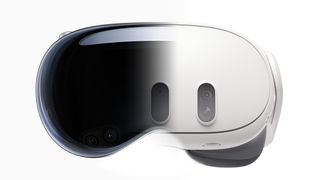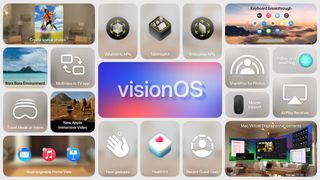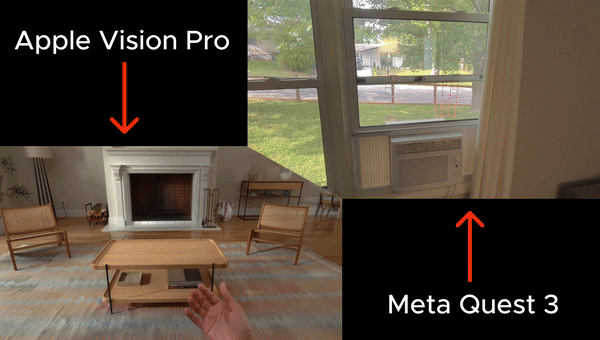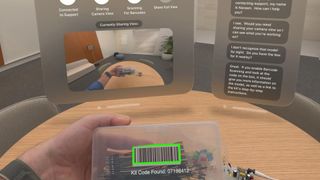Apple and Meta can't stop copying each other
Competition is good for everyone, especially a fledgling industry.

Every year, the same thing happens. Apple's annual WWDC conference happens in early June, and inevitably, we write about all the features Apple stole from Android. It's a fun and mostly tongue-in-cheek affair, as we know that competition is good for everyone and good ideas are best spread around rather than locked behind a proverbial cage with only one key to unlock them.
That's part of why Apple adopting RCS is such a big deal, even if the company doesn't want to do it. But this year, it wasn't just iOS copying features from our favorite Android phones. Rather, we saw Apple copying some of the best Quest 3 features for its significantly more expensive Apple Vision Pro headset.

In his weekly column, Android Central Senior Content Producer Nick Sutrich delves into all things VR, from new hardware to new games, upcoming technologies, and so much more.
Of course, Apple isn't the only one copying things. Just as Google pulls ideas from Apple's small stock of unique and excellent features—many of the best Google Messages features were ripped right from iMessage, after all—Meta is also grabbing great ideas from Apple's first mixed reality headset.
Given the relatively nascent nature of standalone VR — that means a headset that works on its own without being plugged into a PC, console, or smartphone — it makes sense to see ideas grow so quickly and companies one-upping each other every single month. I always say competition is good for everyone, and the battle between the Apple Vision Pro and Meta Quest 3 proves that point.
Finding the right paradigm

You've probably heard it said before that current VR/mixed reality/spatial computing headsets are still in the early smartphone era. Some even called the Vision Pro the "iPhone of VR," alluding to its revolutionary hand and eye-tracking-driven UI. In some ways, it is, but Apple's latest update shows that one company doesn't yet hold all the keys to success.
Case in point: Apple added a brand new home gesture where you pinch your index finger and thumb together to go home. Functionally, it's identical to swiping up from the bottom of your phone to go to your home screen. Ironically, Meta added this exact same gesture to Meta Quest headsets back in February, around the time the Vision Pro first launched.
See for yourself how it works on each headset:
Be an expert in 5 minutes
Get the latest news from Android Central, your trusted companion in the world of Android

While we could whine about how Apple stole Meta's idea or some such nonsense, the reality is that this gesture makes sense. It's something that works every single time and feels good to use. Apple also implemented another gesture that works by rotating your hand around—palm down—then pinching and dragging to adjust the volume.
Apple also borrowed several ideas Meta already implemented, like support for Bluetooth mice and more keyboards, guest and secondary profiles, and even those handy live captions that come with every Android phone. Likewise, Meta's latest updates include handy Vision Pro features like travel mode and spatial videos from iPhones.
On the smartphone side of things, companies have learned over the years that people naturally gravitate to certain behaviors based on what's happening on their phone's screen. Swiping in from the side makes sense to go back, and swiping up from the bottom makes sense to go home. These gestures have been adopted on nearly every phone in existence at this point and it's because they work in a strangely natural way for most users.
Likewise, we're already seeing some UI paradigms take root in the heads of VR power users who regularly swap between headsets. One popular streamer, ThrillSeeker, who has over 700,000 subscribers on YouTube and uses a plethora of different headsets, has already found himself wanting Apple's brilliant Control Center in every VR headset he uses.
I find it very interesting that I have significantly more hours in Quest OS and various SteamVR headsets from years of VR usage and muscle memory- yet after only 3 months of Vision Pro I instinctively look up for control center in every single headset.It’s a surprisingly… https://t.co/bWWDoCCICHJune 6, 2024
Despite putting over an estimated 10,000 into using other VR headsets, Thrill says roughly 200 hours of Vision Pro usage has reprogrammed his brain to expect certain UI paradigms.
Another YouTuber and VR analyst, Brad Lynch, feels the same way about Apple's gaze-and-pinch UI. "Every time I put a HMD on, including Quests, SteamVR, etc., I instinctively try to gaze and pinch to interact with things."
If you're not already aware, the Apple Vision Pro uses eye-tracking inside the headset in combination with hand tracking to navigate its UI. To select something, you merely gaze at it with your eyes and pinch your finger to "click."
Many of us assumed this feeling would arise after using Vision Pro for long enough, but it's another thing to see it play out this way.
What's next?
We're already aware that Meta is working to give the Meta Quest a UI overhaul—an update that's expected later this year—and the company looks to be doing it by not just copying Apple but by introducing other new paradigms that we'll soon come to expect from all VR headsets.
One new thing I'm particularly looking forward to is in-headset smart home control. Instead of pulling out my phone or yelling across the room for Google to do it—knowing that Google Assistant probably won't do the right thing anyway—I'll just point to the light and tap it virtually to turn it on or off.
I fully expect this kind of natural UI paradigm to become more and more prolific as full-fledged AR glasses like the upcoming Meta ones become mainstream. The lack of sleek hardware is holding that vision back a bit, but companies like Meta can continue experimenting with new ideas on mixed reality headsets today, later translating those to successful UI designs in future products down the road.

The Meta Quest 3 is powerful, but it can never fully replicate Apple's vision-gazing UI because it lacks eye-tracking. That's OK, though, as Meta can still adopt other important UI designs.
A mysterious new ad showcased what we can only assume is part of the new UI design, allowing users to place windows anywhere they want in space. One of the new VisionOS 2 updates gave the Vision Pro the ability to remember window placement between reboots, so you can permanently place a giant monitor on your wall or your Discord chats on your desk, and the headset won't forget that.
Apple also introduced barcode scanning in VisionOS 2, as seen in the image above, something that just makes sense when you look at a product through a device like this.
It's these kinds of paradigm changes that will continue to make XR and spatial user interfaces feel more natural and unique. They're the thing that'll begin changing the dialog from "I can just do this on my smartphone" to "I don't want to, or can't do this, anywhere else."
Until then, though, I hope both companies keep ping-ponging off each other's ideas because this is good for everyone.

-
SnowyRVulpix The VR space (Is the Vision Pro VR or AR?) is something I keep rolling my eyes at, but at the same time... I think it's probably the tech space I am most excited to see develop (Second only to desktop computers). The dream of the Apple Vision Pro is really appealing to me. Though that battery pack on the Vision Pro bothers me.Reply
I always say competition is good for everyone,
Absolutely agree. And honestly, we've seen just how badly things can get in markets where there is a lack of competition (Such as the desktop operating system space... No, Recall was a bad idea Microsoft)
